(42,553 statute miles ; 71,126 km)
What an amazing year this has been, jam packed with travelling, voyaging, sight-seeing, action and excitement, like no other we can ever remember. Last Christmas was spent in England with family and friends, with New Year back in our home hamlet of Canada in the New Forest with close sailing friends Martin & Christine from Odyssey of Canada. They moved to within 400m of our home just after we set off in 1999 but we eventually met up in Tahiti in 2002!
Late in January we returned to Oz to begin a 9,000km camping tour which took us down through the parched, red centre of the continent to South Australia, Victoria and incomparable Tasmania (Update 25). Stopping only to give Amoenitas a swift fit-out in Scarborough marina near Brisbane, we began the 2500nm trip up the east coast of Queensland and over the top across the Gulf of Carpentaria to Darwin. (Update 26). There in late July we joined in an international rally of around a hundred boats for the 3 month, 2600nm crossing of Indonesia to Singapore where we arrived on 19th October. Since then we have cruised a further 700nm up the Strait of Malacca, through Malaysia to Langkawi. We plan to be in Phuket, Thailand for this Festive Season.
So, in the space of under ten months we have voyaged 5,890nm (6,800 statute miles, 10,900km) from the South Pacific into the Indian Ocean, a distance equivalent to over a quarter of the way around the globe on the equator. Starting from Brisbane at around 27°S 153°E we have crossed back into the northern hemisphere to 8°N 98°E and are just another quarter of the globe from completing our circumnavigation. Definitely a time for slowing down, taking stock and pacing ourselves.
Our voyage of 454nm from Darwin on Australia's north coast to Kupang in West Timor was an easy one, with winds so consistent we didn't use the engine at all on the three day passage. We have also managed to cross 3000nm of the Pacific from the Galapagos to the Marquesas in 2002 and again crossed from Vanuatu to Australia in 2005 with the same Green credentials. Its a lovely feeling when it works that way, offsetting all the diesel we've used in he last two months crossing the 'Horse Latitudes' back into the northern hemisphere.

Kupang, the bustling capital of East Nusa Tenggara Province, proved to be another one of those culture shocks with 4 million people confined within a relatively small area with incessant traffic and blaring horns. What a contrast to the huge, sparsely populated continent we had just left! However, two hundred odd of us from the around 100 boats on the rally were welcomed regally and whisked off on numerous tours of the area. At the friendly, family run Pak Pah factory at Oebelo on the outskirts of the town we were treated to displays of traditional local dancing, accompanied by these unusual and somewhat rare stringed instruments. This was to be the first encounter with things 'Traditional' in Indonesia which is a widely scattered nation of many tribal groupings, languages, customs and diverse cultures.
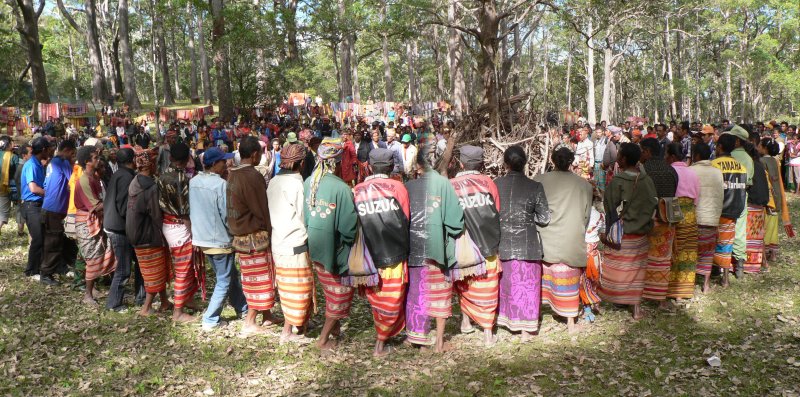
The trip to the Fatum Nasi rainforest way up in the east of the island was one of two bone shaking, all day tours over tracks barely deserving of the term road, leaving us amazed at the skill of the driver and resilience of the coach suspension. They took us way up the northern spine of the island, very close to the border with the troubled, breakaway sister-state of East Timor. These were the first of many visits to Indonesia's many tribes that amazed us with the warmth of the welcome and their hospitality. The slowly rotating dances, continuously moving in and out to a haunting refrain were very common and somewhat reminiscent of a New Year's Eve 'Ald Lang Syne'.

Perhaps its time to broach the subject of Indonesia's infrastructure and transportation. Whilst not truly Third World, it is what one might describe as fairly basic. We include this image for Jim our civil engineering friend who marvelled (wept) at bamboo scaffolding when he and Liz were with us in the Caribbean. Nothing so straight as bamboo here and certainly never a sign of a steel tube. Imagine having to thread your way through the ground floor with an armful of building materials. This particular example was in the town of Labuhan Bajo on the western end of Flores Island.
Communication was another story. Like in so many emerging nations, Indonesia has largely by-passed fixed, copper wire based phones for a very comprehensive mobile network. Look for the red and white tower on almost every island and turn on the phone. Internet connection was another matter. We had many attempts, some islands with large towns like Bima on the island of Sumbawa had never even heard of it. Only in the tourist haven of Bali did we have any success, often spending up to an hour attempting to log onto our land based ISP.

The mainstay of personal transportation is the small motorbike which serves to carry everything from a family of five to bulky loads in huge pannier boxes, precariously roped onto the rear end. Indeed, family cars are rare except in big cities. The roads are narrow, rutted and often under repair, with never a worker in sight. Road signs and markings are minimal but strangely, after the first feelings of vulnerability subside, one realises that everyone has a quiet sense of self preservation, giving way benignly, whatever the perceived right of way. Almost as if there were no rules of the road, so no one could be in the wrong. They do however make incessant use of the horn.

Bikes don't need big petrol stations with pumps, so most fuel is sold in glass or plastic bottles from front gardens by the roadside. This rather neat version was in the town of Kalabahi on the island of Alor. The standard price was 5000 rupiah/ltr or about 29p, just over a quarter of the price in Europe. You need to get used to big numbers when you withdraw 1 million rupiah at a time from the ATM (about £65).

Our mainstay for longer journeys was the bemo or local private minibus which usually had a hustler hanging out of it to collect fares and haul in customers, all to often innocent bystanders too close to the roadside. This one, hired by eight of us for the 10km trip from Kumai to Pangkalan Bun on the island of Borneo was sadly past its best. The first indication of trouble was not the constant scraping of the bodywork against the suspension, the pumping of the brake pedal or the +/- 30° movement of the steering wheel whilst going in a straight line but the refueling. The pipe came through the driver's window to a 25ltr clear plastic bottle by Dave's feet in the passenger seat. Still, suppose it didn't matter whether the fuel gauge worked or not. The finale was a puncture with no spare wheel or jack. In true cruiser style Ian from the Aussie boat China Grove found a stout pole and another passing bemo was flagged down for the loan of a wheel. We knew at once it was a six ply tyre as we could count each one of them. The final note was the emblem of crossed spanners on the plastic sheet covering what had been the rear window. Pity we didn't see that before we got in!
Each of the around 20 official venues for the rally gave us a stupendous welcome, making us feel much more than the humble, unwashed cruisers we really were. Here in Kalabahi on Alor this took on a water-borne form, with one of our number being appointed King for the day and transported ashore to represent us at an elaborate ceremony. Local and ceremonial costumes abounded, this young lady's below being a particularly charming example.

Local beauties in traditional dress were always at hand
Whilst at Alor we were taken to the Takpala traditional village, set high on a hillside overlooking the ocean. The old ways had been preserved, from living in large communal houses on stilts, to wearing traditional garb and bearing ancestral weapons. What the place looked like on a day they were not open for visitors is anyone's guess. The highpoint of the visit was some of the most moving dance we have ever seen. The group revolved slowly as usual but the haunting chant of the lead male, coupled with the droning response and synchronised chiming of the leg bangles made for a very special experience.
This Takpala male carried all the armaments of his forbearers. Such visits were also sales opportunities with a wide selection of craft articles displayed for sale. These were mainly woven goods, skirts, table covering and ikats which are a form of decorative scarf. or skirt. The traditional method of weaving relied on natural dyes which were applied multiply to lengths of yarn so that when woven, they would create a quite complex pattern. Not the sort of task we would ever contemplate without the aid of a computer generated and controlled dying process.

All the Indonesian archipelago is on the Pacific 'Ring of Fire', being extremely volcanically and earthquake active. We would sail for days alongside islands ringed with perfectly formed volcanic cones, some still belching fumes. The downside to this for cruisers is that the shores of the islands are generally steep-to with very limited opportunity to find a sheltered anchorage. Inevitably the 'Kilimanjoro Kid' couldn't resist the challenge and set off before dawn with a bemo load of friends to tackle Illiape on the island of Lembata. It proved to be a demanding 5hr ascent in hot weather and over terrain that hardly ever offered more that a few metres of unobstructed pathway. A delayed start and scare over the brakes of our bemo failing on a steep hill leading to the sea had left us tacking the worst of the climb over a scree slope without cover of vegetation in the worst heat of the day. Still, five of us made it to the crater rim at 1420m (4658ft) having started by the sea shore. Never had beer tasted so good as those consumed when we finally returned to the village just before dusk.

Mates on the hill : To the right of Dave is Frank from near Scarborough Marina where we stayed in Oz (he and wife Nikky were guests on another boat). In the centre, Steve from the US on Ariel who we had first met in the Caribbean in 2001. Next to the end, good friend Keith from Kirsten Jayne, fellow HAM and fleet techno-geek. On the right is Midge from Oz on Fourstar who we had just got to know on the day.
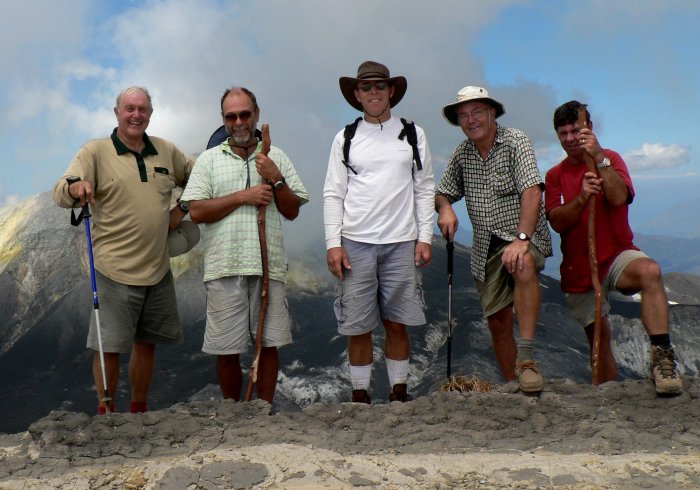
Another vulcanology based excursion was to the three crater lakes at Kelimutu in Ende province on Flores. Six of us hired a driver and 4WD to take us nearly four hours into the mountain over pretty 'interesting' roads. Here we are with two of the lakes in view. Their colours vary with the season and over time due to changing mineral content. Here we can see the turquoise and black ones, the green crater being behind the camera.

On the north shore of Lembata is the village of Lamalera. Because of its traditional link with old whaling methods, it has a dispensation from the International Whaling Commission, to catch up to around 25 animals a year. This is accomplished in true Moby Dick style from open, rowed boats with a steel tipped wooden spear.

Demonstration of whale hunting skills at Lamalera
It looks and is a hard, dangerous way to get staple protein and fats. Fishermen are killed nearly every year. The hunt over, getting the heavy craft up the steep sandy beach presents yet another set of backbreaking problems.
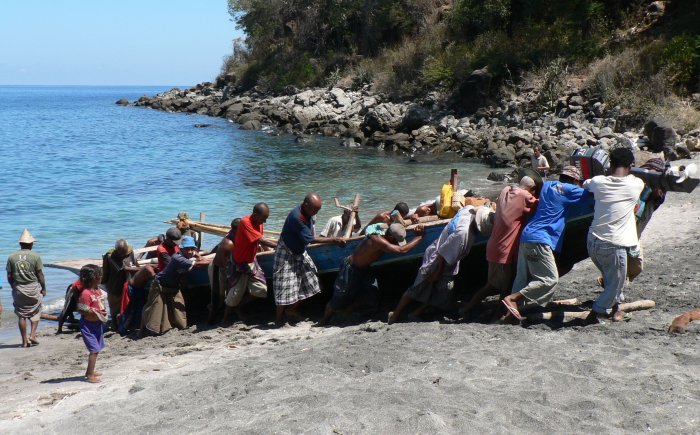
Recovering the boat up the steep beach is no mean feat
The houses of the village are surrounded by drying racks covered with whale meat. There is no strong smell and eating it proved a disappointing experience of tough, fibrous, black chunks. Why the Japanese want to make themselves so unpopular, flouting world opinion, to persecute the specie is beyond understanding.

Whist in Lamalera we picked up an interesting trophy in the form of a dried shark's jaw. We think it is from a Mako, one of the most dangerous species, with rows of displaced, extremely sharp teeth that would make escape impossible. We have done the best job we can, preserving the cartilage based structure which we hope to get back to the UK some day.

On the western end of the large island of Flores, next to the island of Komodo are a large number of small islets in shallow waters which have been adopted as a marine park and are hosts to the most amazing range of marine life we have seen anywhere. Our anchorage above was on the island of Sebayor Kecil about 15nm west of the town of Labuhan Bajo. We spent a rare four days there snorkeling, diving and climbing the surrounding barren hillsides. The sides of the pass marked by deepish blue water were home to the most sensational hard and soft corals, rare anemones, bivalve molluscs, etc, etc. Each day we would time a drift snorkel with the ebbing tide for a mind boggling experience. If you are interested in underwater pictures, check out Update 4 of our Marine Page from the link at the top of the Homepage.

Waters in this part of the world are overrun with more fishermen than you feel could ever populate the shorelines. They normally fish at night using small paraffin pressure lamps like the one this guy has, or on larger vessels with a bank of generator driven electric lamps housed in huge reflectors. Either way, they are a pain in the butt to nighttime passage makers. If that weren't enough they often lay out nets that may, or may not have an identifying light. There are also unlit floating fishing rafts offshore, constructed of bundles of bamboo poles. Even worse are the tugs towing huge barges on 400m long lines where only the tug is lit. Back to the picture, note how clear the water was at Pulau Bedil, a small sandy creek on the way to Bali.

Styles of house construction across this chain of 17,508 islands spanning 2900nm (5370km) of tropical ocean deserve a web page of their own. We've chosen this example of a Bugis house, constructed on stilts over a marsh by the sea at Lingeh on the island of Flores. The Bugis people are ancient tribe of fishermen and traders who have given their name to this type of house, as well as the most convenient MRT station (underground) in Singapore for Dave's electronics mecca, the Sim Lim Towers.

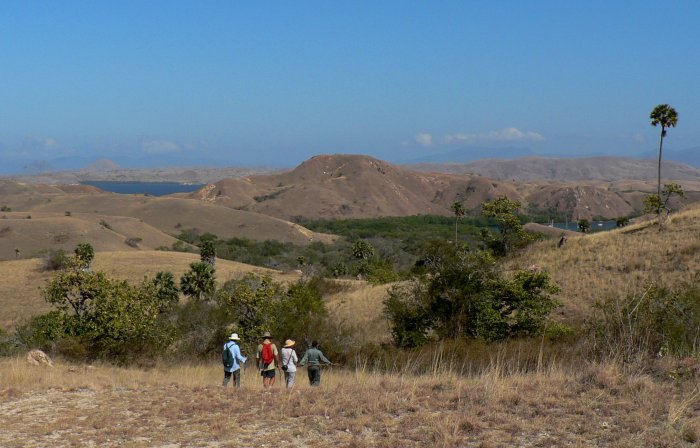
Two special treats had been promised by those who came before us and we were about to discover the first between the islands of Flores and Komodo. These are the gargantuan reptiles, the legendary Komodo Dragons. They are the world's largest lizard, reaching over 3m in length, weighing up to 100kg and feeding on animals as large as deer and buffalo. Their secret is a deadly cocktail of over sixty poisons in their saliva, such that the a bite is not immediately fatal but given a few days their prey is so incapacitated that it can be eaten live. Here Di and Ian with our guide are beautifully framed behind a very photo savvy male.

We were lucky enough to witness an encounter between a large male advancing along a track towards us and a female crouched by nearby nesting holes. She immediately sensed she was in trouble, heading up the steep hillside at a rate of knots, with said 'gentleman' in hot pursuit. We followed at a safe distance to observe what appeared to be a strange 'dominance' ritual. She lay there still whilst he crawled on top of her, poking her neck with his front claws. Don't think it was the other thing? Eventually he allowed her to escape, when she came down the hill at an even greater rate, passing not much more than a metre from an aprehensive Dave, nervously clutching the camera. Any loss of definition is the result of camera shake!

No tale of these islands would be complete without some exposure to the markets. Shops are usually a big disappointment to cruisers as they sport only a few tins of tuna, dry biscuits and a plethora of tooth rotting sweet goods. Supermarkets are extremely rare and often not much more use than the shops. So, markets it is then. This charming lady with her mouth watering stall of fresh(ish) meat was in Bima on Sumbawa but could have been anywhere in the country. Enough to covert anyone to becoming vegetarian!
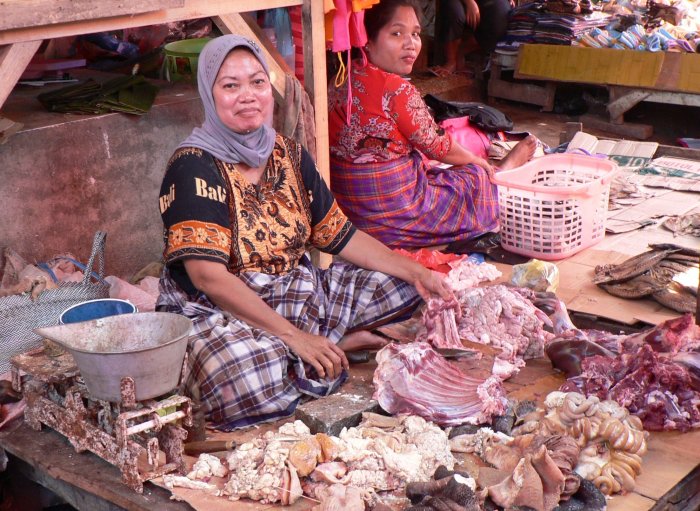
Quite the most common stall item through Indonesia and Malaysia is dried fish in various sizes and colours. Can't think I ever remember eating them but they must be a staple ingrediant for something. Certainly locating them is no problem, it is achieved using the nose at a range of around 20m.
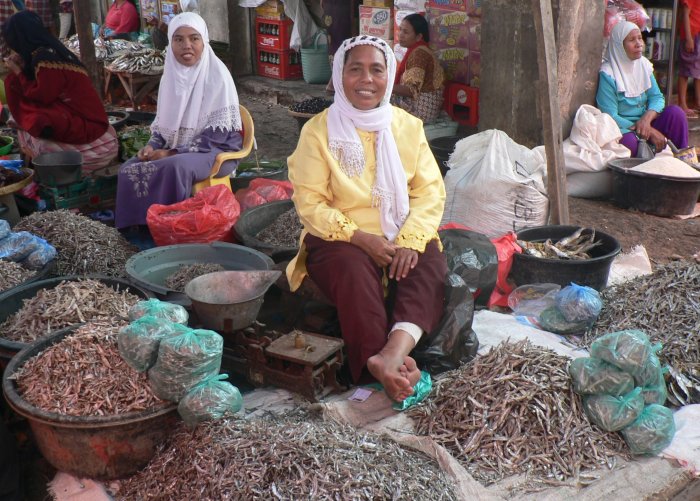
A little more disturbing is the poultry department, like this one in Kupang where birds are tethered by strings or confined in small cages. It is not unusual to come across odd ones tied up in the middle of the pavement outside any shop, necessitating a rapid detour whilst having a quick visual check for signs of H1N5.
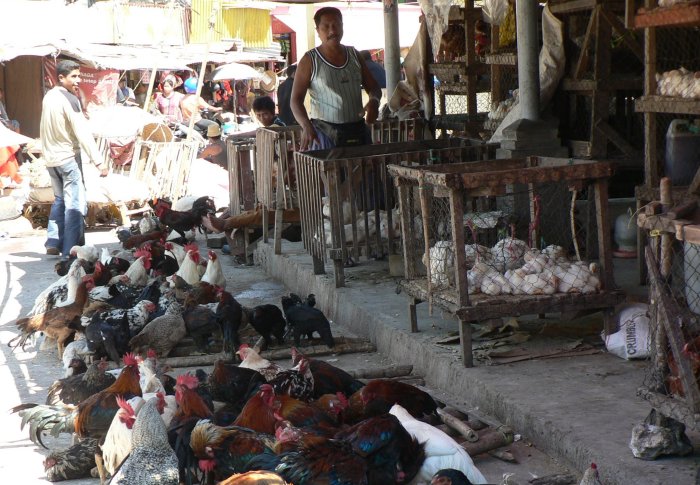
Around a thousand miles from Kupang where we entered Indonesia is the island of Bali, home to the vast majority of the tourist trade and recent target for two notorious bombings. For us it was a haven of internet contact and supermarkets such as Carrefour that left us speechless for several minutes. Tourism is focused on the south of the island so our anchorage at Lovina on the north coast was relatively free from constant pestering by hawkers. We hired a car and driver with Oz friends Ian & Chris to tour the island for a few days. Below is part of the royal palace at Singaraja in the centre of the island. The building's function was as a chilling-out place with a wonderful painted ceiling depicting events, mainly mythical from the history of the kingdom. Guess you are supposed to view it in the well known chilling out on the back position.
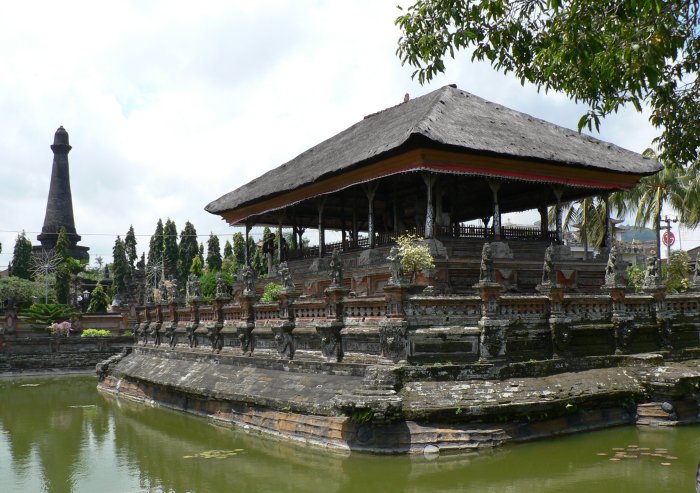
There is a significant Hindu influence on the island with some magnificent temples. Below is a view of just a minute part of the Temple at Besakih on slopes of Mt Agung. This is an enormous complex of 23 separate but related temples with the title 'Mother Temple' as its role is island wide. Almost every village has at least three temples, the most important being dedicated to the village founders. Families worship their ancestors in family temples, clans in clan temples, etc. This makes for a crowded island where most of the habitation area is taken up by temples!
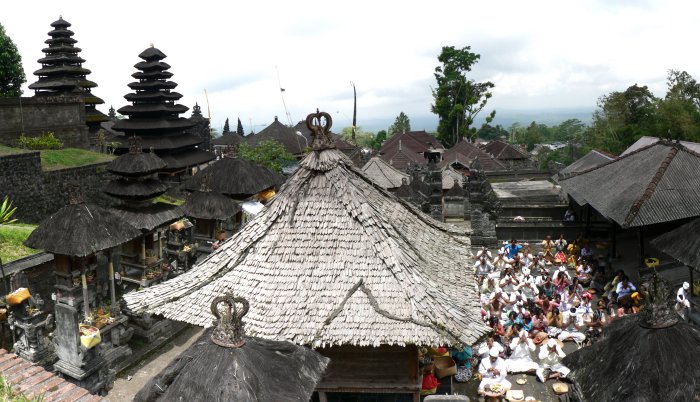
Bali was a special gathering point on the rally as many had diverged and this was to be a big re-union before we all set off for Singapore, still 800nm away. True to the reputation for lavish welcoming ceremonies, hospitality and groaning tables, this really was a night to remember. Below are three of the belles from the colorfully dressed troupe of around 50 dancers that performed for us.
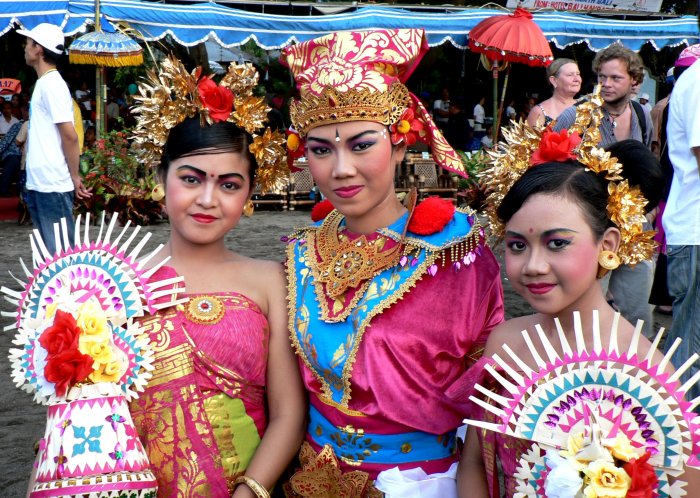
Having traveled westwards for most of our journey, it was now time to head north through the South China Sea for the Malay Peninsula. Almost on the way was the SW coast of Borneo where we had been told that our second major treat awaited near the river town of Kumai in the Indonesian province of Karamantan. This was the enigmatic primates known in the local tongue as 'People of the Forest' (Orangutan). Just another trip to see the relatives then! First though, we had to navigate 20nm up a shallow river and survive several nights in Kumai at the height of Ramadan. The image below shows just one of about five mosques close by our river anchorage off the town. All are equipped with huge speakers, just visible, driven by multi-Kw audio amplifiers, each designed to out shout the neighbours. The call to prayer began at about 04.15 and seemed incessant till nearly midnight.

Access to the Tanjung Puting National Park was by a five hour boat trip in a traditional klotok following narrow channels through the rainforest. Visible in the canopy were macaque monkeys leaping from branch to branch and a wealth of birdlife. Sadly we didn't see any sun bears, clouded leopards, pythons, gibbons, porcupines, sambar deer or crocodiles that also frequent the area but we did see wild boars and giant Bornean butterflies. The four guests had sole access to the upper deck which we shared with Keith & Carol from Kirsten Jayne. Below, even closer to the unsilenced 20hp diesel engine were the two boat crew, guide and cook. At night mosquito nets and side awnings were erected to make a cosy home, deep in the wild rainforest of Borneo.
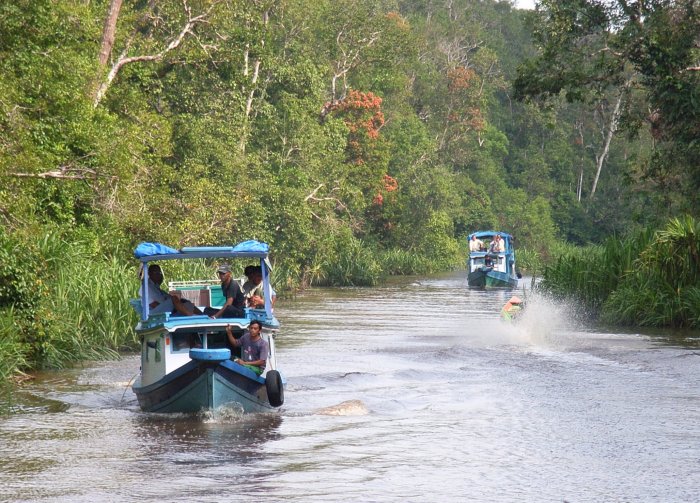
We visited three colonies of these rare primates that only survive now on the islands of Borneo and Sumatra. They are the subject of painstaking conservation, supported mainly from overseas trusts in Europe and the US. We probably saw about 40 of them, each an incredible experience that left us feeling extremely privileged to have the opportunity to observe them. The dominant males with their distinctive cheeks that develop after around 19 years are truly awesome. We attended several feeding times when a clearly defined pecking order was followed to come in from the trees for milk and bananas. By way of a finale, to our two days in the forest, as we returned down river at dusk, we were treated to the spectacle of thousands of fireflies in the pandanus palms fringing the river bank.
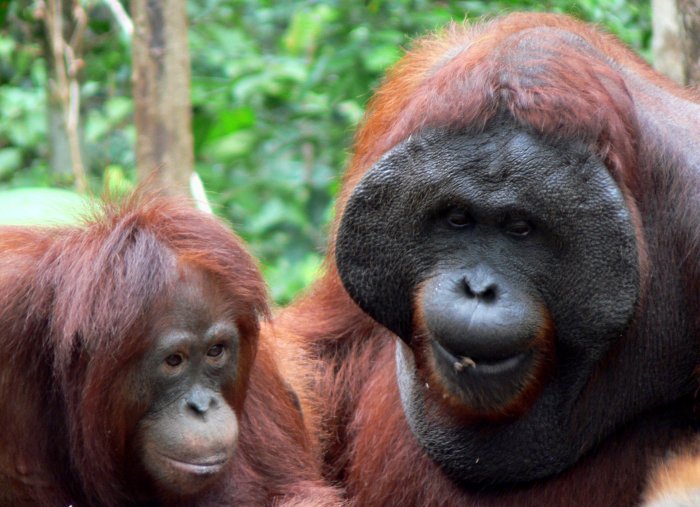
The median age of Indonesia's population of around 245 million is less than 27 years, so no tale of a stay there would be complete without an image of the children. They were lots of fun, everywhere taking a great interest in us, crying 'hey mister' and where possible engaging in any form of communication. They also loved having their picture taken, so keeping them far away enough to get them all in the frame was usually the problem. This bunch were in a charmingly decrepid Bugis village on the outskirts of the town of Maurole on Flores.

Where to next:-
It is only around 200nm from where we are to Phuket in Thailand and there are lots of charming islands on the way. We will be there by mid-December, all ready for what should turn out to be a very special and mega social Festive Season with lots of new-found friends from the rally.
Our longer term sailing plans are, as is usually the case, set in jelly but for the moment we are very happy to have a quiet year around this neck of the woods. Its all very easy hereabouts, if a little warm but we are used to that. In March we are returning to England for about six weeks to be with Kitty, Di's Mum for her 90th birthday. When we return we plan to do some land touring in Asia, probably to Cambodia and Vietnam. After the Olympics are over we hope to have a serious crack at China.
Meanwhile, there is a lot of sailing to be done around the mass of islands to the north and we hope to get a visa from India to visit the Andaman Islands in around a years time. The trip across the Indian Ocean and up the Red Sea to the Med via Suez can wait until we really feel we are 'cruised out'. Fortunately no signs of that yet but the appearance of grandchildren has introduced another factor into the equation. Still, it is much easier for us to return to Europe from here and of course for visitors to come to us.